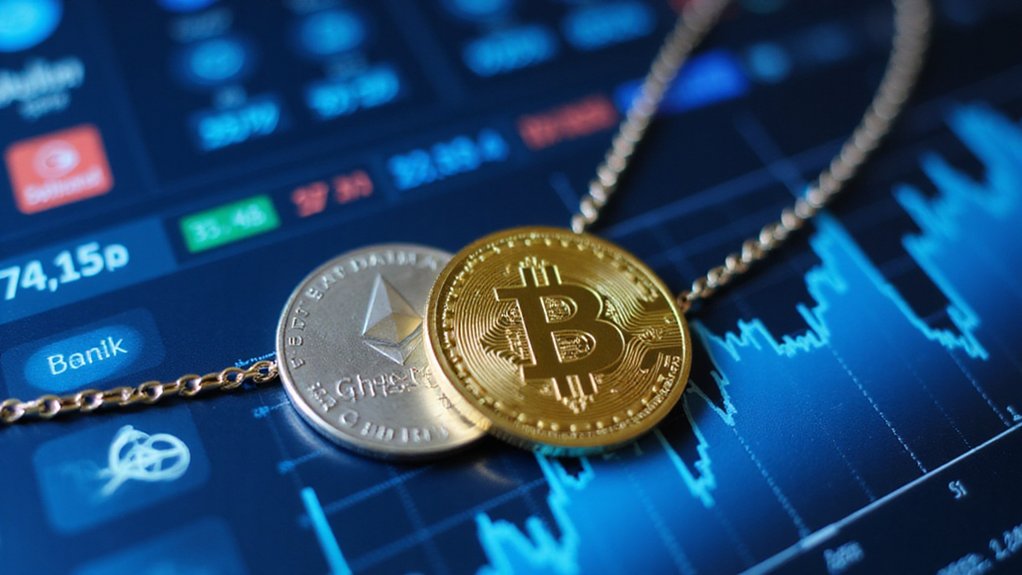DeFi (Decentralized Finance) represents a revolutionary reimagining of financial infrastructure on blockchain technology, primarily Ethereum. This parallel financial universe operates continuously without traditional intermediaries, credit checks, or geographic restrictions. Users maintain full control through digital wallets, executing peer-to-peer transactions via smart contracts that function as self-executing agreements. With over $13 billion committed to Ethereum-based protocols, DeFi offers lower fees and unrestricted access—though its transparency and code-dependent security present unique vulnerabilities for the uninitiated.

A financial revolution—quiet yet seismic—has been unfolding in the digital domain over the past few years.
This phenomenon, known as Decentralized Finance or “DeFi,” represents a fundamental reimagining of financial infrastructure, replacing traditional intermediaries with blockchain-based protocols that enable peer-to-peer transactions.
Built primarily on Ethereum’s digital backbone, this ecosystem creates a parallel financial universe where the conventional gatekeepers—banks, brokerages, and clearing houses—find themselves rendered obsolete by lines of code.
DeFi’s architecture relies on distributed ledgers that record transactions in cryptographically secured blocks, creating an immutable history that resists tampering.
Users maintain control through digital wallets housing private keys—the modern equivalent of both vault combinations and property deeds.
At the heart of this system lie smart contracts, self-executing agreements that automate complex financial operations without human intervention (a development that would surely cause Keynes to raise an eyebrow).
Smart contracts represent autonomous financial machinery that operates without human hands—a financial automation Keynes never imagined possible.
The implications of this technology extend beyond mere efficiency.
DeFi creates financial mechanisms accessible to anyone with internet connectivity and a digital wallet—no credit checks, government IDs, or minimum balances required.
Transactions occur pseudonymously, with wallet addresses rather than personal information, while assets move across platforms with unprecedented fluidity.
The system operates continuously, calculating interest by the second rather than quarterly, with all activities transparent on public blockchains.
This transparency, however, reveals DeFi‘s paradoxical nature: its security model simultaneously represents its greatest strength and potential vulnerability.
While blockchain’s distributed nature makes tampering computationally infeasible, poorly coded smart contracts can introduce catastrophic vulnerabilities¹.
Despite these risks, capital continues flooding into the ecosystem, with over $13 billion committed to Ethereum-based DeFi protocols alone.
The ecosystem’s health and popularity are often measured by Total Value Locked, which reflects the amount of digital assets users have committed to various protocols.
What we’re witnessing is not merely a technological upgrade but a paradigm shift—the unbundling and reimagining of financial services without geographic or institutional constraints.
Through direct negotiations between participants, DeFi platforms typically offer lower transaction fees than traditional financial systems while eliminating geographic restrictions.
DeFi empowers users with full control of their assets through direct ownership, eliminating the need for approval or permission when transferring funds at any time.
Whether this represents finance’s ultimate evolution or merely its latest experiment remains, like the markets themselves, uncertain.
¹The immutability that makes blockchain secure also makes errors permanent.
Frequently Asked Questions
How Risky Are Defi Investments Compared to Traditional Finance?
DeFi investments present substantially higher risk profiles than traditional finance channels.
With smart contract vulnerabilities, minimal regulatory oversight, and extreme market volatility, investors face potential catastrophic losses without recourse—a stark contrast to traditional finance’s established guardrails.
While DeFi offers unprecedented accessibility and innovation (not to mention those attractive yields), the absence of institutional safety nets means participants fundamentally trade security for opportunity, operating in an environment where a single code flaw can evaporate millions overnight.
Can Defi Platforms Be Regulated by Government Authorities?
Government authorities can regulate DeFi platforms, though not without significant challenges.
The regulatory landscape spans multiple agencies (SEC, CFTC, FinCEN), each grappling with DeFi’s decentralized architecture.
Regulators have primarily targeted “front-end” interfaces—the vulnerable centralized components in otherwise decentralized systems.
Upcoming IRS reporting requirements exemplify this approach.
However, the fundamental tension remains: how to apply frameworks designed for intermediaries to protocols explicitly designed to eliminate them¹.
¹As previously discussed, this regulatory complexity contributes to DeFi’s risk profile compared to traditional finance.
What Skills Do I Need to Participate in Defi?
Participating effectively in DeFi requires a multifaceted skill set spanning technical prowess and financial acumen.
Essential competencies include blockchain fundamentals, programming knowledge (particularly Solidity), and smart contract comprehension.
Financial literacy—encompassing risk management and market analysis—proves equally essential.
Security awareness can’t be overlooked, as DeFi’s permissionless nature demands vigilance against vulnerabilities.
Networking within communities accelerates learning, while continuous education remains imperative in this rapidly evolving space where yesterday’s innovation becomes tomorrow’s antiquated protocol.
How Do Defi Protocols Handle Security Breaches?
When the inevitable security breach strikes, DeFi protocols typically deploy multi-layered response strategies. These range from immediate incident containment (freezing compromised contracts) to post-mortem code audits that reveal how attackers exploited those million-dollar semicolon errors.
The more sophisticated protocols maintain bug bounty programs, insurance reserves, and governance mechanisms allowing rapid community response.
Yet, despite these measures, the sector’s approach often remains frustratingly reactive rather than preventive—a costly education system where users’ funds finance the tuition.
Which Blockchain Offers the Most Efficient Defi Ecosystem?
While Solana purportedly offers the most efficient DeFi ecosystem with its remarkable throughput (thousands of transactions per second) and minimal fees, efficiency depends on prioritized metrics.
Ethereum, despite congestion issues, provides unparalleled security and adoption.
Polygon delivers cost-effective scalability as Ethereum’s Layer 2.
Avalanche boasts impressive finality times with eco-friendly credentials.
The “most efficient” blockchain ultimately hinges on whether one values raw speed, security, developer ecosystem, or sustainability—a calculus that shifts with market demands.









